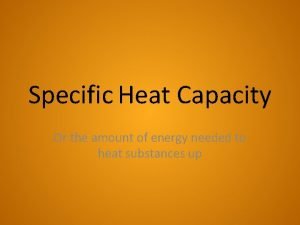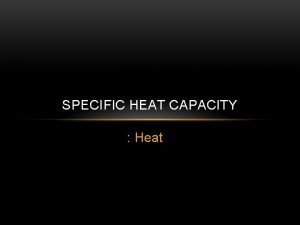Topic Specific heat capacity Level GCSE or any




- Slides: 4

Topic Specific heat capacity Level GCSE (or any course for students aged 11 -16) Outcomes 1. To understand the concept of specific heat capacity when a substances warms up and cools down 2. To understand the difference between thermal energy stores and kinetic energy stores When to use Use this task once students have been taught about temperature, kinetic energy and specific heat capacity. Useful link: http: //hyperphysics. phy-astr. gsu. edu/hbase/thermo/inteng. html Instructions for teachers: allows students to discuss the explanations in small groups before resolving misconceptions as a class. www. thescienceteacher. co. uk | resources for science teachers who like to think

The pizza has been in the oven at 200 o. C for 15 minutes. You take the pizza out of the oven and eat a slice. ‘OUCH!’ you’ve burnt your mouth on the cheese – but not the crust. Specific heat capacities: cheese 3270 J/kgo. C and crust 2800 J/kgo. C. Discuss each of the explanations below. Who is right and who is wrong? The cheese is hotter than the crust when it comes out of the oven as it has a higher specific heat capacity. Malcolm The cheese can transfer more energy to your mouth when it cools down as it has a higher specific heat capacity. The cheese and crust particles are at the same temperature so have the same amount of energy. They should burn equally! Jo David

Name Response Malcolm This is incorrect. Assuming the pizza has been in the oven for long enough, both the cheese and the crust will have reached the same temperature. The cheese will just have taken longer to reach that temperature as it has a higher specific heat capacity – more energy is needed to raise it’s temperature. Jo The cheese and crust are at the same temperature and therefore have the same kinetic energy – they have the same amount of energy in their kinetic energy stores, but they will have different amounts of energy in their thermal energy stores due to their different specific heat capacities. David When you put a given mass of cheese or crust in your mouth the change in temperature between your mouth and the food causes energy transfer by heating. The amount of energy that can be transferred depends on the specific heat capacity of the substance. So the cheese, with its high specific heat capacity, transfers more energy than the crust when it cools down and hence burns your mouth more.

Possible workings out Food Specific heat capacity (J/Kgo. C) Energy transferred from transferred to the thermal energy store to increase when 1 kg of food 1 kg of food by is placed into the 175 o. C (J) mouth at 37 o. C (J) Cheese 3270 572, 250 533, 010 Mushrooms 1840 322, 000 299, 920 Bacon 1050 183, 750 171, 150 Dough 2800 490, 000 456, 400







